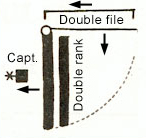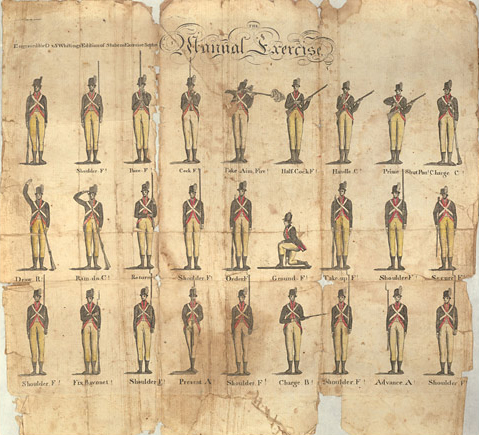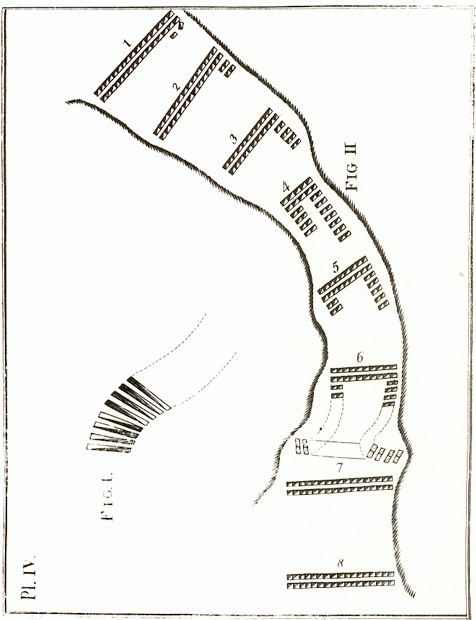Basic Training
Three different hand-tinted engravings of the commands comprising the manual of arms appeared in various editions of Steuben’s Blue Book between 1800 and 1807. This one was featured in the “Improved edition” of the Regulations of “Baron de Stuben” published by Daniel and Samuel Whiting of Albany, New York, in 1803. F stands for firelock; C stands for cartridge; R stands for ramrod. That edition included the U.S. Militia Act of 1792 and the “Law Organizing the Militia of the State of New York, as now amended.”
Steuben’s Regulations for the Order and Discipline of the Troops of the United States opened with the rudiments that had to be taught to each recruit. The first was to stand “straight and firm upon his legs, with the head turned to the right so far as to bring the left eye over the waistcoat buttons; the heels two inches apart; the toes turned out,” etc.); the appropriate postures for “Attention” and “Rest”; dressing right and left; facing right, left, and “about.” The “Common Step” was next (“two feet, and about seventy-five in a minute”), then the “Quick Step” (“about one hundred and twenty in a minute”). Once the recruits had learned the basics, they were trained in groups of three to “March by Files” and to execute the “Oblique Step.” Next, taken separately again, each was taught “The Position of a Soldier under Arms.”
The first major objective of basic training was mastery of the “Manual Exercise,” or manual of arms. It involved 27 commands from the sergeant, calling for 56 motions by the recruit. The single command, “Prime and Load,” involved fifteen motions.
Recruits had to learn to measure the proper length of a slow step or a quick-march step in unison with one another. They also had to learn to measure time by instinct. Steuben insisted that each soldier was to be “very exact in counting a second of time between each motion.” Recruits who were often semi-literate at best, and who might never before have seen a clock or watch, much less used one, seriously challenged an instructor’s ingenuity. But with a single detachment as small as the Corps of Discovery, that precision would probably have been easier to achieve, as far as it was needed.
It is doubtful that Lewis and Clark anticipated any need to teach the formal manual of arms to all their men, who represented a mixture of experienced soldiers and raw recruits. Marksmanship, which Clark stressed at Camp Dubois, was more important. From the outset, the captains recognized the necessity of developing as many good hunters as possible.
Two of Steuben’s Basic Maneuvers
Passage of a defile by a column. A column on its march coming to a defile, which obliges it to diminish its front, the officer commanding the first platoon commands Break off! On which those files which cannot pass, break off, face inwards, and follow their platoon by files, and as the defile narrows or widens more files will break off, or join the platoon.
The maneuver illustrated here shows the successive adaptations of the two ranks of a company (#8) as they proceed through a defile between two roads where they might be ambushed by a hostile army.
Wheel Maneuver

The objective was to keep the company at maximum battle-readiness at all times, prepared to discharge successive volleys of musket fire followed by frontal, slow-step bayonet charges.
Another basic military maneuver taught by Steuben was the wheel. A company of soldiers marching in double file would execute a “left face.” Then while a corporal at the head of the left file turned in place, the two lines of men behind him described a quarter-circle to create a double rank ready for battle.
Most of the rest of Steuben’s Regulations were directed toward methodical preparations for every eventuality that might be encountered in combat—assuming the enemy would operate according to identical principles and procedures.
Corps Maneuvers among the Shoshone
Lewis and Clark would have had no need for most of the directions in Steuben’s book. Hostile Indian bands would not have met them with orderly mass maneuvers, but would have fought one-on-one. Besides, the Corps was either river-bound on the barge, pirogues or canoes, or if moving overland, on horseback or on foot leading pack horses.
The captains taught their men some quick, simple but showy maneuvers to impress Indian audiences. As the Corps drew near the principal Lemhi Shoshone village on 26 August 1805, Lewis explained,
Cameahwait requested that we would discharge our guns when we arrived in sight of the village in the plain I drew up the party at open order in a single rank and gave them a runing fire discharging two rounds. they appeared much gratifyed with this exhibition.
The rapid successive reports from 20 rifles twice around must have startled and thrilled the villagers.
The only other routines the Corps needed would have been those involved in parade—a mustering of the troop for display, or for inspections at which detachment orders would be read. Inspection parade was a twice-daily routine, at least at Camp Dubois. Parades before Indian observers probably would have been short, involving only “Present—Arms!” and “Shoulder—Arms!” from the manual of arms. Maneuvers would perhaps have been limited to “To the Right—Wheel! March!”
Steuben’s instructions for captains directed them to inspect soldiers’ weapons daily. After the expedition got under way, those inspections were held frequently, at least according to Sergeant Floyd’s journal.


